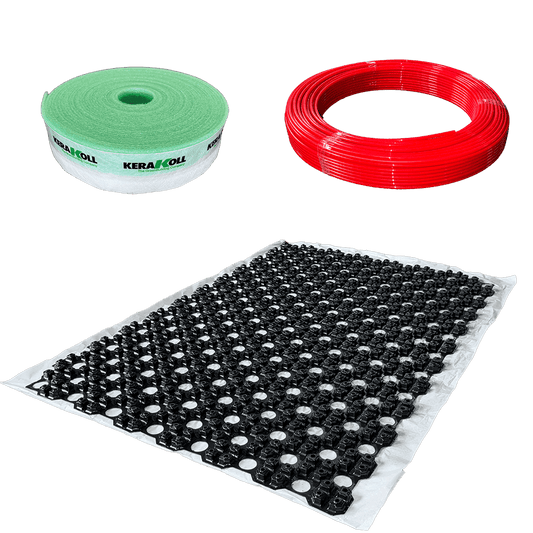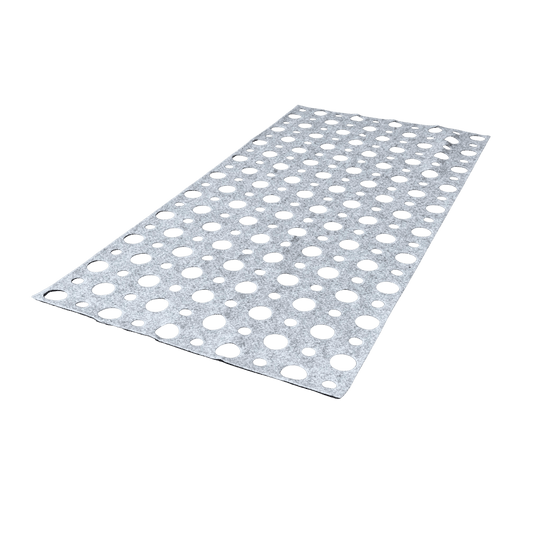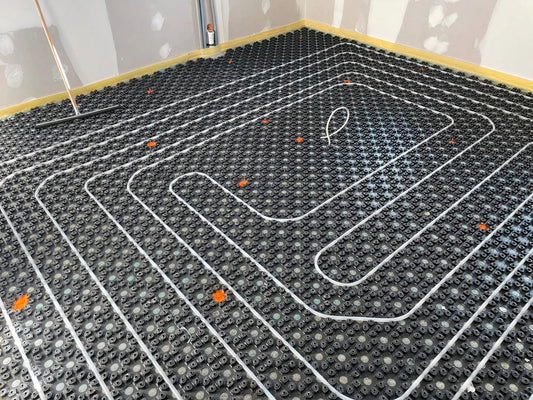
Underfloor heating in old buildings: Thin-layer system as the perfect solution ✅
Georg CholewaShare
Retrofitting underfloor heating in an older building often sounds complicated—especially due to the limited installation height and the floor's load-bearing capacity. However, a thin-film system offers an efficient solution that requires little space, offers even heat distribution, and significantly increases living comfort. Modern thin-film underfloor heating systems are specially designed for renovations and can be easily integrated into older buildings. They operate with low flow temperatures, save heating costs, and are ideal for operation with heat pumps or condensing boilers. 🔥
👉 In this article, you'll learn why underfloor heating is worthwhile in older buildings, the advantages of a thin-film system, and how it's installed. We'll also provide an overview of costs and tips for optimal installation. Discover the thin-film underfloor heating system in older buildings now.
Table of contents Underfloor heating in old buildings
- 1. Why underfloor heating in an old building?
- 2. Challenges of retrofitting old buildings
- 3. What is a thin-film system?
- 4. How does a thin-film system work
- 5. Advantages of the thin-film system in old buildings
- 6. Installation of a thin-film system
- 7. Costs of thin-film underfloor heating
- 8. Conclusion: Is underfloor heating with a thin-layer system worthwhile in an old building?
Why underfloor heating in an old building?
Many owners of older buildings are considering modernizing their heating systems – and underfloor heating offers numerous advantages. Compared to conventional radiators, it ensures even heat distribution, making cold feet a thing of the past. It can work particularly efficiently in unrenovated older buildings with high ceilings and poor insulation, as it distributes heat over a large area, thus creating a pleasant indoor climate. 🌡️
✅ Another advantage is energy efficiency: Underfloor heating systems operate with low flow temperatures, which reduces energy consumption – especially when combined with a heat pump or modern condensing boilers. This can save heating costs in the long term.
✅ In addition to the comfort and cost benefits, aesthetics also play a major role: Since bulky radiators are eliminated, more living space is created, and the design possibilities are virtually unlimited. In addition, underfloor heating can increase the value of the property, as modern heating systems are an important factor for potential buyers.
But how can underfloor heating be installed in an older building without extensive renovations or high costs? This is where the thin-film system comes in – a smart solution specifically for underfloor heating renovations in older buildings.
Challenges of retrofitting old buildings
Retrofitting underfloor heating in an older building presents several challenges. Unlike in new buildings, the structural conditions are often limited, making choosing the right system particularly important. Here are the biggest challenges to consider:
Limited installation height and load capacity 📏
In many older buildings, floor structures are thin and ceiling heights are limited. A conventional wet system with screed would raise the floor too much, which can lead to problems with doors and connections. Furthermore, wooden joist ceilings in older buildings are not designed for heavy screed layers. A thin-layer system offers the optimal solution here, as it requires minimal installation height (usually only 17–30 mm) and is lighter than conventional systems.
Thermal insulation and heat loss ❄️
Many older buildings have inadequately insulated floors, which can lead to high heat loss. For underfloor heating to work efficiently, appropriate insulation is necessary – especially for rooms above unheated basements or ground floors. Modern thin-film systems can be combined with special insulation panels to minimize heat loss and increase efficiency.
Connection to the existing heating system 🚰
Older buildings are often equipped with gas, oil, or district heating systems, which operate with high flow temperatures. However, underfloor heating only requires a flow temperature of 30–40 °C to function efficiently. Therefore, it is important to consider whether the existing system can be adapted or whether a combination with a heat pump or condensing technology makes sense.
Cost and time factor 💰🕒
Retrofitting underfloor heating in an older building requires planning and investment. While the thin-film system reduces construction costs and time, material costs, installation effort, and potential subsidies should still be considered. Despite these challenges, modern thin-film underfloor heating systems offer an attractive solution for older buildings. In the next section, you'll learn how these systems work and what variants are available.
What is a thin-film system?
A thin-layer underfloor heating system is a special solution that's particularly suitable for older buildings. It's characterized by its low installation height and low weight, allowing it to be easily installed on existing floors – without complex renovation work or high screed layers.
How does a thin-film system work
In contrast to traditional wet screed systems, which are often 30–100 centimeters thick, the thin-layer system relies on a minimal installation height of 17–30 mm. The heating pipes are integrated directly into special installation panels or milled screed surfaces and covered with a thin leveling layer. This allows the underfloor heating to respond quickly to temperature changes and heat efficiently.
What types of thin-film systems are there?
There are two main variants that are suitable depending on the surface and requirements:
1. Thin-layer system in wet construction 💧
- The heating pipes are embedded in a thin layer of special screed.
- Particularly suitable for solid surfaces such as concrete floors.
- Good heat transfer, but longer drying time.
2. Thin-film system in drywall construction 🔥
- The heating pipes are inserted into prefabricated installation panels (e.g. gypsum fiber or aluminum panels).
- Ideal for wooden beam ceilings or old buildings with low load-bearing capacity.
- Quick assembly and immediately ready for use.
- No wet screed required.
Materials and special features 🔩
- Special screed or leveling compound ensures even coverage of the heating pipes. With Kerakoll's Planogel Rheo leveling compound, you can achieve pipe coverage of at least 5 mm.
- Milling technology enables the integration of the pipes into existing screed floors without additional construction.
- Installation panels such as the ArdusAlu with heat conducting plates optimize heat distribution.
Thanks to these properties, the thin-film system is the optimal choice for retrofitting underfloor heating in older buildings. In the next section, you'll learn about the specific advantages of this solution.
Advantages of the thin-film system in old buildings
Underfloor heating with a thin-layer system offers a number of advantages that make it the ideal solution for renovations in older buildings. Thanks to their low installation height and light weight, these systems can be easily retrofitted without significantly compromising the structural stability or room height.
Ideal for renovations thanks to low installation height
One of the greatest advantages of a thin-layer system is its minimal installation height of just 17 mm with the Velcro system and 18 mm with the dimpled film. This allows door heights and connections to be maintained, and eliminates the need for complex structural modifications. This is a crucial factor, especially in older buildings with limited floor space.
Fast response time and efficient heat distribution
Due to the system's low mass, the floor heats up faster than with conventional screed systems. This means rooms can be heated quickly to the desired temperature – a clear advantage over conventional underfloor heating systems with a thick screed layer, which take longer to heat up.
Low weight - ideal for wooden beam ceilings
In older buildings with wooden beam ceilings, the weight of the underfloor heating plays a major role. Traditional wet screed systems are often too heavy for the load-bearing capacity of such ceilings. A drywall thin-layer system with installation boards and heat-conducting sheets offers the perfect solution, as it is significantly lighter and places no additional strain on the building structure.
Compatible with modern heating systems
A thin-film system can be easily combined with modern heating technologies such as:
- Heat pumps for maximum energy efficiency
- Condensing technology for optimal use of fossil fuels
- Solar thermal systems for sustainable heating
The low flow temperatures of the underfloor heating reduce energy consumption, which leads to lower heating costs.
Can be flexibly combined with various floor coverings
Thin-film underfloor heating is suitable for a wide range of floor coverings:
- Tiles and natural stone offer the best thermal conductivity.
- Vinyl and laminate are compatible as long as they are approved for underfloor heating.
- Parquet can be laid if it is suitable for hot water underfloor heating.
Thanks to this versatility, the system can be used in a wide variety of living spaces and usage scenarios. With a thin-film system, underfloor heating can be efficiently retrofitted in older buildings without significant changes to the existing structure. It offers significant energy savings, rapid thermal comfort, and easy installation, making it the perfect solution for modernizing older buildings. In the next section, we'll show you the installation process step by step.
Installation of a thin-film system
Installing thin-film underfloor heating in an older building is significantly easier than conventional systems, as it doesn't require a thick layer of screed. However, some important steps must be taken to ensure efficient heating performance and a long service life.
Preparation of the subsoil
Before the underfloor heating is installed, the subfloor must be checked and prepared:
✔ Clean and level the surface: Unevenness should be leveled with a leveling compound.
✔ Apply insulation: A thin layer of insulation reduces heat loss and improves energy efficiency.
✔ Install edge insulation strips: These prevent sound bridges and allow the necessary expansion of the floor.
Laying the heating pipes and pouring the screed
Depending on the system, there are different installation methods:
🔹 Drywall thin-layer system: The heating pipes are inserted into prefabricated installation panels with heat conducting sheets.
🔹 Wet construction thin-layer system: The pipes are integrated into a milled screed layer or thin casting compound.
Make sure that the pipes are laid evenly to ensure optimal heat distribution.
Drying times and commissioning
- If a cast screed has been used, it must dry sufficiently.
- After the drying time, the heating pipes are pressure tested for leaks.
- The heating is turned up slowly to avoid stress cracks in the floor covering.
Proper installation is crucial to ensure optimal heating performance and long-term system durability. Detailed instructions for the thin-film system can be found here .
Choosing the right floor covering
Any remaining unevenness must be leveled before the flooring is applied. After that, the flooring can be installed. A thermally conductive flooring ensures efficient heat transfer. Particularly suitable are:
✅ Tiles and natural stone (best thermal conductivity)
✅ Vinyl and laminate (must be approved for underfloor heating)
✅ Parquet (only as a glued version with suitable wood)
Costs of thin-film underfloor heating
How much does thin-film underfloor heating cost in an old building?
Costs depend on various factors, including the size of the area, the selected system, and the effort required for installation. For the NerthusFlow thin-layer system with a dimpled film, you can expect the following average costs. The material costs refer to the complete thin-layer system for an 18 mm installation height, including PERT heating pipe, special edge insulation strips, and dimpled film, as well as the additional leveling compound, which is calculated at approximately 1.6 kg per mm of layer thickness per m²:

| Cost factor | Costs in EUR |
| material | 35 |
| Installation by a specialist company | 30 - 60 |
| Flooring | 20 - 80 |
🔹 Total costs per m²: approx. 85 – 175 €, depending on the floor covering and the chosen technology.
Savings potential through lower heating costs
Because underfloor heating operates with low flow temperatures, heating costs can be reduced by up to 20–30% – especially when combined with heat pumps or condensing boilers. Thin-layer underfloor heating in older buildings can drastically reduce heating costs.
Conclusion: Is underfloor heating with a thin-layer system worthwhile in an old building?
Underfloor heating with a thin-layer system is the ideal solution for old buildings, as it requires minimal installation and still offers efficient heat distribution.
✅ Pleasant warmth and more living comfort
✅ Energy savings through low flow temperatures
✅ Easy installation without major modifications
✅ Compatibility with modern heating systems
Despite the initial investment, retrofitting can pay off in the long run through lower heating costs and increased property value. If you want to modernize your existing building while heating it efficiently, a thin-film underfloor heating system is the right choice.
👉 Discover high-quality thin-film underfloor heating systems as well as suitable solutions for dry screed underfloor heating for the renovation of old buildings in the MC Therm Shop and benefit from innovative heating systems for your home!








